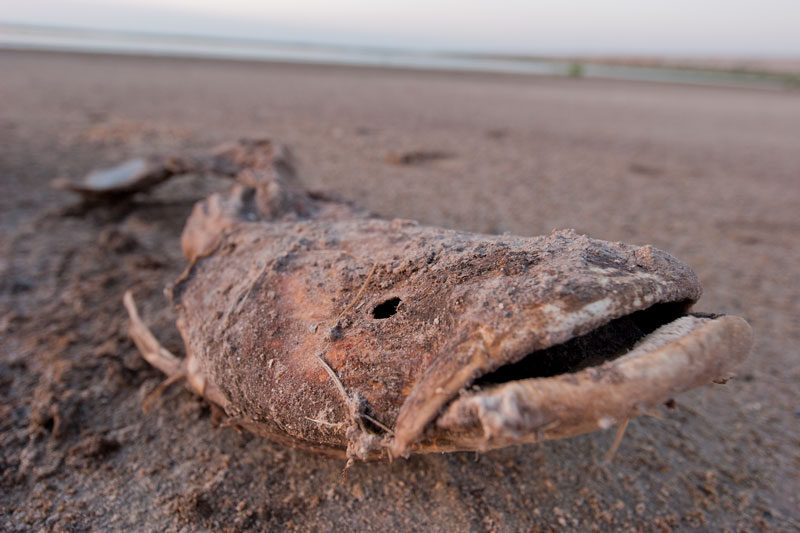
Everyone Supports the State Water Plan, So Now What?

Above: Dead catfish at OC Fisher Reservoir near San Angelo
Today was a marathon day for discussion of funding the state water plan. In both House and Senate committee hearings, it seemed like everyone with something to say on the issue—in other words, a ton of people—got their say. Agriculture, energy interests, water utilities, environmentalists, San Antonio Mayor Julian Castro, big engineering firms and so on.
Support for funding the $53 billion water plan appeared to be unanimous. Everyone pledged fealty to water conservation. The question now, as Sen. Troy Fraser (R-Horseshoe Bay) suggested this morning, is *how* the financing is structured. Will the consensus hold, or will interests fracture along regional and economic lines?
“We can’t afford to pit one [group] against another,” said Laura Huffman, of the Nature Conservancy. “A growing state is going to want to eat, drink and turn the lights on.”
Much will depend on whether key lawmakers—Rep. Allan Ritter (R-Nederland) and Fraser in particular—can craft a fair structure for distributing what will likely be billions of dollars over the coming decades.
“I think it’s like most of the issues that come before this body,” said state Rep. Doug Miller (R-New Braunfels). “Follow the money.” Austin American-Statesman reporter Asher Price did just that. He found that one of the organizations behind the push for a state water bank, H2O4Texas, is funded by “industries that stand to benefit from massive projects to move water around the state.”
That’s not terribly surprising but suggests that legislators will have to be careful to guard against allowing the water bank to turn into a slush fund.
The key word is: prioritization. The state water plans lists 562 distinct water projects, a wish list drafted by hundreds of “stakeholders” organized into 16 regional water planning groups. Those projects are the essence of the plan. But how do you pick which ones to fund? What form does the funding take—grants, loans, etc? Which projects get funded first? Do conservation-focused projects receive a leg up or is the money going to flow into new reservoirs?
Ritter’s legislation, House Bill 4, has been praised by environmentalists for requiring that at least 20 percent of the funds go toward water conservation.
Sen. Fraser’s legislation, Senate Bill 4, would create a fund outside of the state treasury but would put the Texas Water Development Board in charge of prioritizing the projects. But Fraser repeatedly complained today that the board is ill-equipped to take on such a huge task. Fraser said he’d had trouble getting a simple list of water-supply projects that the board considers top priorities.
Under Senate Bill 4, the Water Development Board would be run by three full-time commissioners instead of six part-timers. It would also set up a nine-member advisory committee to recommend water projects to the full board. Other senators, however, piled on Fraser’s proposal, leading him to stress that it was a work in progress and likely to be negotiated until the bitter end.
Perhaps the most compelling testimony came from mayors, including San Antonio’s Julian Castro, Houston’s Annise Parker as well as the mayors of Abilene, Midland and San Angelo. The message was that cities have done a tremendous amount of infrastructure-building and water conservation but that state support is critical.
“Further economic development and the population growth that comes with it require new water supplies,” said Castro. “The challenge is funding.”
The West Texas mayors, who have faced a near-crisis situation during the current drought, presented a unified front. For the last two years, San Angelo, Midland and Abilene have worked together on long-term solutions to the drying up of large reservoirs the cities rely on.
Alvin New, the mayor of San Angelo, pointed out that the city was only a year away from running out of water. Beneficial rainfall in September bailed San Angelo out temporarily; the city now has a 20-month supply, a bit of breathing room while a pipeline is built to tap an aquifer 60 miles away.
Abilene, meanwhile, is working on Cedar Ridge Reservoir, a $240 million reservoir proposed for the Brazos River. Mayor Norm Archibald described Cedar Ridge as an “incredibly significant financial investment,” one that can’t be undertaken without state support. Permitting alone will cost $12 million and is bound to draw opposition. For one, the reservoir would reduce flows on the Brazos River system, which is already running low. The Brazos River Authority also has a water rights application pending before the Texas Commission on Environmental Quality that would effectively lock up most of the “extra” water in the basin.
A project as expensive, complex and politically fraught as a new reservoir may be in West Texas’ interest, but what about the rest of the state? State Rep. Bill Callegari questioned the wisdom of building a new lake when the region’s other surface water supplies have dried up.
“What are you going to do differently to make sure you can fill them first and keep them full?” he asked.


